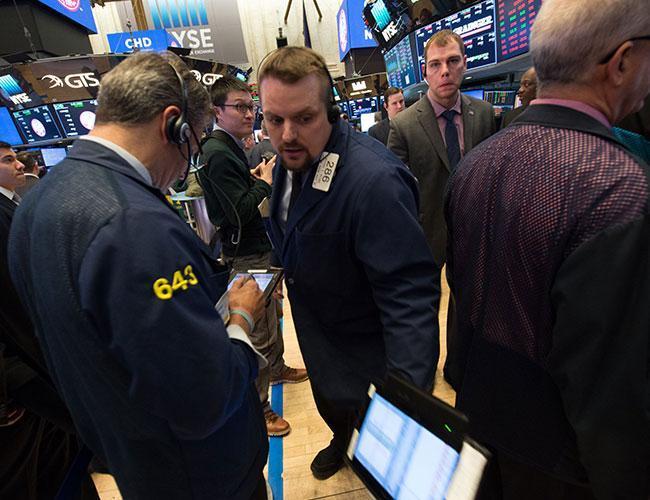
Panic gripped trading floors across the world on Feb. 6, with Asia and Europe plunging after record-breaking losses on Wall Street, as investors fretted over the prospect of rising U.S. interest rates and took profits following months of markets euphoria.
The selloff began on Feb. 2 when bright U.S. non-farm payrolls data sparked fears that inflation will surge this year -- and that the Federal Reserve will be forced to raise borrowing costs more quickly than anticipated.
On Feb. 5, U.S. stocks saw the biggest one day fall in six years as investors rushed to take profits, after bond yields rose sharply last week, following an equities rally to record levels in January.
The Dow Jones Industrial Average fell nearly 1,600 points for its biggest intraday drop in history in points terms, or more than 6 percent, before ending down 1,175.21 points, or 4.6 percent, its biggest one day fall since Aug. 2011.
Only last month the Dow and SP500 index had their best monthly gains in two years with stocks reaching record levels on Jan. 26, supported by the benefit of cut in U.S. corporate taxes in December, rising earnings, and healthy global economic growth.
But with the Federal Reserve seen likely to raise short term interest rates again three or four times in 2018, bond yields have been rising, and last week’s healthy U.S. labor market report sparked fears of rising inflation, leading to the sharp bout of profit taking.
The CBoe Volatility index closed at its highest since August 2015.Selling hit all SP sectors, though the SP financial index, down 5 percent, was the biggest daily percentage decliner, followed by healthcare, down 4.6 percent.The Dow Jones Industrial Average fell 1,175.21 points, or 4.6 percent, to 24,345.75, the SP 500 lost 113.19 points, or 4.1 percent, to 2,648.94 and the Nasdaq Composite dropped 273.42 points, or 3.78 percent, to 6,967.53.
US rattle hits Asian, European markets
The panic sales then spread to both Asian and European markets. Asian stocks plunged on Feb. 6 after the record-breaking loss on Wall Street.
Tokyo led a collapse throughout the region, briefly diving almost seven percent before closing down 4.7 percent.
Hong Kong was down more than four percent and Sydney and Singapore each sank three percent.
Other assets were also hammered, with a slump in oil prices scything energy firms, while higher-yielding currencies have been hit by a flight to safe havens.In initial trade on Feb. 6, European stock markets collapsed by about 3.5 percent, mirroring dramatic falls across Asia.
Emerging equities tumbled three percent on Feb. 6 to over one-month lows, set for their worst daily fall since November 2016 as the global stocks rout intensified, including Turkey’s main stock exchange, which slid nearly 2 percent in the initial session.
MSCI’s benchmark emerging stocks index fell 2.8 percent to over one-month lows, taking its cue from developed markets after Wall Street suffered its biggest percentage drop since August 2011.
“The fear is that should inflation rise faster in the U.S. then the Fed would have to tighten more than is currently priced in, which would mean a stronger dollar, plus higher financing costs and lower capital flows to emerging markets,” said Jakob Christensen, head of emerging markets research at Danske Bank, as quoted by Reuters on Feb. 6.
He added that the sell-off was not a sign the world economy was heading for trouble, but more a reflection of stretched valuations in global equity markets after a prolonged bull run without any big corrections.
‘No doom and gloom
’“It’s not doom and gloom, and it’s not financial markets Armageddon; it’s just a much needed and much overdue correction,” AxiTrader analyst James Hughes told AFP yesterday.
“There are four stages of a fall: Hope, greed, panic and fear. We are not at fear, but we are at panic at the moment -- which is only natural after a 1,175-point fall.”
Markets usually grind to the upside, but fall like a rock, said analyst Naeem Aslam at trading firm ThinkMarkets.“Traders have been looking at the market for the past year moving in one direction which was skewed to the upside. Now, it’s time for the bears to take their revenge.”